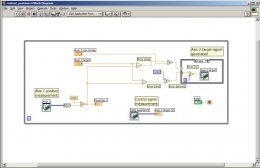edolch
2008-06-19 11:10:10 UTC
Hi, I'm configuring a task in LabVIEW and a PCI 6251 to improve the presicion of positioning of a movement stage of two axes. I'm reading the position of the first axis from a laser encoder with a counter input (quadrature A B, linear position) and when the error signal is less than certain value then I write an analog signal to control the axis 2 (configured as on demand generation). See attached figure 'loop'. I have configured the reading of the position as HW Timed a clock rate and sampling rate of 2 Hz (see figure 'axis 1'). The program work very well but if I increase the frequency of aquisition, then appear an "data overwritten" error in the position aquisition measurement at counter input. Is there another way of doing this task more rapid?, I have heard that frequencies of 1 kHz are the maximum rate for an application like mine, limited by the loops contained in the program.Thanks in advance,Eduardo
loop.jpg:
Loading Image...
Axis 1.jpg:
http://forums.ni.com/attachments/ni/250/40940/2/Axis 1.jpg
loop.jpg:
Loading Image...
Axis 1.jpg:
http://forums.ni.com/attachments/ni/250/40940/2/Axis 1.jpg